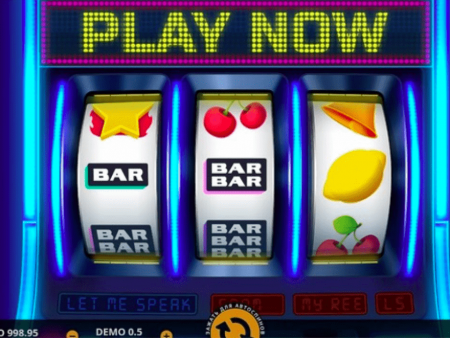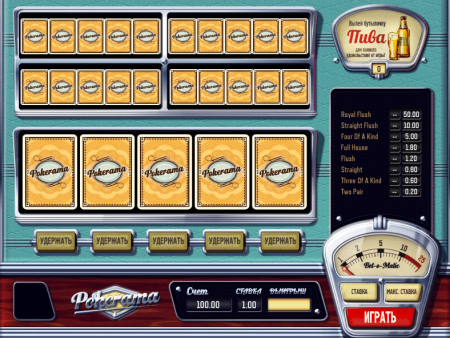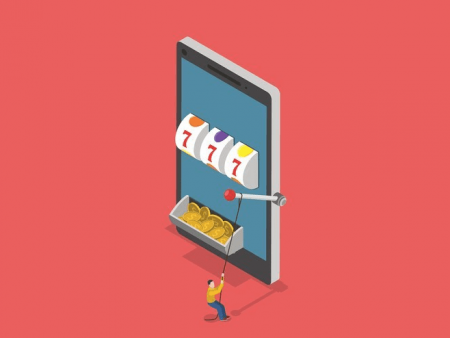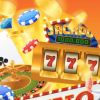
 Выигрыши в онлайн казино
Выигрыши в онлайн казино В этой статье мы расскажем о принципах игры в онлайн казино. Причем эти принципы работают почти для всех видов азартных игр, где можно делать ставки. Самыми известными и популярными считаются:
- игровые автоматы
- рулетка
- блэкджек
- баккара
Наверняка вы уже знаете, что при долгой игре преимущество всегда на стороне казино, поэтому нет гарантированного способа выиграть. Иначе владельцы казино теряли бы деньги все на этих играх.
Для каждой игры преимущество казино зависит от правил игры и правил выплат при выигрыше. Эти правила применяются постоянно, от раунда к раунду. Статистика работает в пользу казино при долгой игре: даже если вам повезло выиграть крупную сумму, но вы продолжите играть, в конечном итоге все равно рискуете проиграть.
Но нередко можно поиграть несколько раундов и выиграть. В таком случае результат вашего визита в казино будет случайным — он зависит от вашей удачи и не зависит от статистики. Это именно шанс, когда удачливые игроки выигрывают и могут сбить статистику преимущества казино. Именно поэтому такие игры казино, как слоты и рулетка, называют азартными — их исход случаен и зависит от удачи.
Важно иметь представление о 2 основных характеристиках игры: коэффициент выплат и дисперсию.
Коэффициент выплат (RTP)
RTP дословно переводится как возврат игроку (процент отдачи). Показатель RTP определяет, сколько ставок игрок сможет вернуть из всех сделанных им ставок на определенном слоте в долгосрочной перспективе.
Рассчитывается этот показатель по простой формуле: сумма всех выигрышей делится на сумму ставок (в процентах). Если результат получился меньше 100%, то коэффициент будет на стороне казино. Процент преимущества казино рассчитывается: 100% минус RTP. Например, если процент выплат составляет 95%, то процент преимущества казино 100% — 95% = 5%.
RTP для большинства игр в казино колеблется в пределах от 95% до 99% Давайте посмотри, как отличается процент отдачи в разных азартных играх.
Процент отдачи рулетки
В европейской рулетке вероятность выигрыша при ставке на черный цвет составляет:
делим количество черных цифр (их 18) на общее количество цифр (37). Если мы ставим на какой-нибудь цвет, то наш выигрыш удваивается. Тогда коэффициент выигрыша в рулетке составляет: 2 * 18 / 37 = 0.973 = 97.3%. Вероятность выигрыша казино составляет 100% — 97.3% = 2.7%. В рулетке установлен один и тот же РТП для всех видов ставок (на цвет, цифры и т.д.).
Если вы играете в рулетку и поставите сразу все свои деньги, то в среднем вы потеряете 2.7%. Но если вы будете делать ставки снова и снова, то каждый раз будете терять по 2.7% в среднем от каждой ставки — в итоге проиграете гораздо больше.
Процент отдачи в блэкджек
В разных казино правила игры в блэкджек могут меняться. Показатель RTP тоже может быть различным. Но в основном блэкджек при использовании базовой стратегии дает RTP в 99,5%. Обычно в настоящих казино процент отдачи колеблется в районе 95%-102%. Это зависит от того, как считать карты. Игроки, которые оценивают фактический RTP в блэкджек, пытаются сделать ставку выше, при условии что RTP более 100%. Это делается для того, чтобы выигрывать в дальнейшем. С другой стороны, у казино тоже есть средства, с помощью которых, он пытается помешать игроку в подсчитывании карт.
Процент отдачи игровых автоматов
RTP в слотах колеблется в пределах 92% — 97%. Он зависит от символов на виртуальных барабанах, таблицы выплат и других правил конкретной игры.
Процент отдачи игр и систем ставок
Нужно понимать, что процент быстрых выплат определяется в каждой игре. К примеру, вы поставили $100 на рулетку и выиграли $1200. Вы продолжаете играть и ставите еще 12 ставок: $100 = $1200. RTP должен рассчитываться для каждого раунда отдельно. Статистическая ожидаемая прибыль казино в этом случае будет составлять:
($100 + $1200) * (100% — 97.3 %) = $1300 * 2.7 % = $35.1
Примечание. Эти 97.3% — это RTP рулетки. Если вы продолжите играть с вашим выигрышем, то ждите того, что вы проиграете больше. Многие игроки продолжают играть со своим выигрышем снова и снова.
Профессиональные игроки должны различать RTP игры (которая считается для каждой конкретной игры) и процент выплат системы ставок. Система ставок определяется игрой всего вашего пребывания в казино. В него включают: вид игры, разновидности/настройки, правила размера ставок и решения о прекращении игры.
Давайте разберемся, что такое RTP системы ставок. Это отношение суммы всех побед выигравших игроков на отношение других игроков, которым не повезло.
Внимание! Иногда игроков вводят в заблуждение, меняя эти показатели местами на сайтах. Так создается впечатление, что игроки теряют только небольшую часть своих денег (ровно столько, сколько выигрывает казино), а остальные деньги должны распределяться между победителями. Но это неверно. На самом деле, если игроки ставят деньги с предыдущего выигрыша, они теряют намного больше. В данном случае, RTP системы ставок может упасть до 50% — то есть вы потеряете половину своих денег.
Оптимальная система ставок — где RTP одинаковый для всех игр. Для этого вы должны избегать ставок из выигрыша. Самый легкий способ — поставить все свои деньги в одном раунде. Держите удовлетворяющую вас ставку в игре до тех пор, пока вы не выиграете или проиграете. Такая стратегия отлично подходит для рулетка, где вы можете оценить свои шансы.
Предположим, что у вас есть $100 и выигрыш в $900 удовлетворит вас. В данном случае размещение $100 на квадрате (4 номерах) будет оптимальной стратегией для вас. В таком случае вы либо выиграете у казино большую сумму, либо останетесь без $100. В данном случае ваши шансы вполне справедливы. Но у такой стратегии есть большой недостаток — вам придется играть недолго.
Дисперсия в азартных играх
Дисперсия показывает, как быстро меняется ваш капитал во время игры. При небольшой дисперсии вы выигрываете часто, но небольшие суммы. В таком случае ваш капитал меняется равномерно (к сожалению, в сторону убывания). Если дисперсия большая, то победы будут редкими, но крупными. Получается, что медленная потеря денег оправдывается большим выигрышем.
Дисперсия игры также может быть описана статистическим распределением суммы выигрыша. Как правило, выигрыш пропорционален ставке. Например, когда ставка на цвет в рулетке, увеличивается в 2 раза при выигрыше. В то же время, ставка на какое-то конкретное число увеличивает выигрыш в 36 раз.
Разница (дисперсия) на игровых автоматах более сложная. Можно много раз выигрывать в различных комбинациях сумму, кратную вашей ставке. Поэтому в слотах сложно сказать конкретно, т.к. много зависит от провайдера и определяется как «небольшой», «средний», «высокий» потерей. Мы решили, что дисперсия игровых автоматов должна быть описана лучше и сделали отдельную тему про нее.
Дисперсия оказывает большое влияние на ваши шансы уйти с казино с выигрышем. Главное правило: чем выше дисперсия, тем лучше. Первая причина высокой дисперсии в том, что в одном раунде вы можете выиграть такую сумму, которая вас удовлетворит. Вторая причина — вы проигрываете больше раундов и не хотите дальше делать ставку (оказывает негативное влияние на RTP). Другими словами, вы очень быстро потеряете свои деньги. Третья причина — если вы можете выиграть сумму больше кратной ставке, то вы уменьшаете ставку, чтобы выиграть ту же сумму. Это снова уменьшает сумму ставки и ваши долгосрочные потери.
Интересно, что многие не оценивают дисперсию, как оценивают РТП. Часто игру судят исключительно по ее RTP — рулетка хуже блэкджек, т.к. у нее более низкий RTP. Такой подход неправильный. Рулетка с ее отношением 36:1 (при ставке на цифру) намного прибыльнее при выигрыше, чем блэкджек (без подсчета карт). Высокая дисперсия лучше с математической точки зрения. Игрок должен научиться использовать ее в свою пользу.
Как дисперсия влияет на RTP системы ставок
Давайте представим двух игроков: каждый из них пришел в казино со $100. Игрок X ставит $10 на номер в рулетке. Игрок Y ставит на цвет. Каждый из них проигрывает казино часть своих денег. Игрок уходит, если в его выигрыш превысит $500 или он проигрывает все свои деньги.
Игрок X оставил казино из своих выигранных средств 14.8 %. Его средний капитал составил $648 и он в среднем играл 16 раундов. Это значит, что RTP системы ставок составил 95.19 %.
Примечание: RTP системы ставок рассчитывается, как отношение выигрышей к чистым убыткам. Чистые выигрыши рассчитываются: 14.8% * ($648 — $100). Чистые убытки рассчитываются как $100 * (100 % — 14.8 %). Получается (($648 — $100) * 14.8 %) / ($100 * (100 % — 14,8 %)) = 95.19 %.
Игроку Y удалось выиграть только в 5.15% всех попыток. Его система дала средний выигрыш в размере $500, и RTP составил 21.42%. С другой стороны игрок Y любит долго играть — в среднем он сыграл 274 раундов.
Этот пример доказывает, что дисперсия влияет на шансы выиграть в казино. Коэффициент выплат системы у игрока X был 4,4 раза выше, чем RTP системы, используемой игроком Y.
Как размер ставки влияет на RTP системы ставок
Сумма выигрыша в азартных играх зависит от размера ставок. Общий коэффициент выплат системы ставок также влияет на размер ставок. Правило простое: чем выше размер вашей ставки, тем выше RTP системы ставок. Мы предполагаем, что все остальные правила системы ставок остаются прежними.
Для примера докажем влияние размера ставок на результат системы ставок. Обратимся снова к рулетке. Игроки приходят в казино со $100 и останавливаются, если их капитал составит 0 или превысит $500. Игрок X ставит $20 и игрок Y ставит $5. Оба игрока ставят на цвет.
После много раз сымитировали такую ситуацию и выяснили, что в 10.9 %, игроки выиграли $500. Это значит, что RTP составил 48.68% и в среднем было сыграно 84 раунда. С другой стороны, игроку Y из миллиона попыток удалось добраться до цифры $500, всего в 0.88% случаях (в среднем 706 раундов, RTP 3.55%). Это говорит о том, что если игрок Y хочет уйти с казино с выигрышем в $500, то ему нужно выиграть в 80 раз больше, чем проиграет. Это крайне маловероятный случай для рулетки.
Очевидно, что при низкой дисперсии вы можете играть дольше, но ваши шансы выиграть крупную сумму денег значительно падают.
С другой стороны интересно сочетание высокой дисперсией и высокой ставки. Игрок Z пришел в казино со $100 и решил все поставить на 1 номер. Вероятность выигрыша игрока Z составляет 2.71%. В случае выигрыша каждый игрок уйдет с выигрышем $3600 (RTP 97.4 %).
Рекомендуемая система ставок в рулетке
Какую систему ставок выбрать, чтобы иметь хорошие шансы на победу? В таблице ниже приведены результаты нашего исследования. Переменной является размер одной ставки и типом ставок (цвет/число). Каждый игрок начинает со $100 и уходит, если выигрывает $500 и больше.
Как вы видите, высокая дисперсия при ставках на цифры в 10 раз выше, чем при ставке на цвет. Кроме того, игра будет длиться намного дольше.
При ставке $2 на цвет ваши шансы выиграть $500 стремится к 0. Из миллиона попыток не выиграл никто.
Если вы хотите с азартом провести время и иметь хорошие шансы на победу, то мы советуем игру с максимальной дисперсией и играть малыми ставками.
В рулетке с бюджетом в $100 лучше всего делать стаки по $2 — $4.
Делаем выводы
- Процент выплат (RTP) азартных игр рассчитывается для каждого конкретного раунда. будет намного меньше, Если вы ставите выигранные в предыдущем раунде деньги, то этот показатель будет сильно меньше.
- RTP вашей системы ставок зависит от RTP игры, дисперсии игры, размера ставок и правил при уходе и продолжении игры.
- Дисперсия игры определяется размером потенциального выигрыша (кратным ставке). Чем больше ставок выигрывает, тем выше дисперсия.
- Высокая дисперсия может легко побить более высокий RTP: высокая дисперсия лучше с точки зрения математики.
- Чем выше дисперсия, тем больше шансов сорвать большой выигрыш.
- Чем выше ставка в одном раунде, тем выше RTP вашей системы ставок.
- Выбирайте игру с высокой дисперсией и с маленькими ставками. Несколько побед приведут вас к хорошему выигрышу (или вы все проиграете).
- Важно найти баланс между длительностью игры и RTP вашей системы ставок.



















